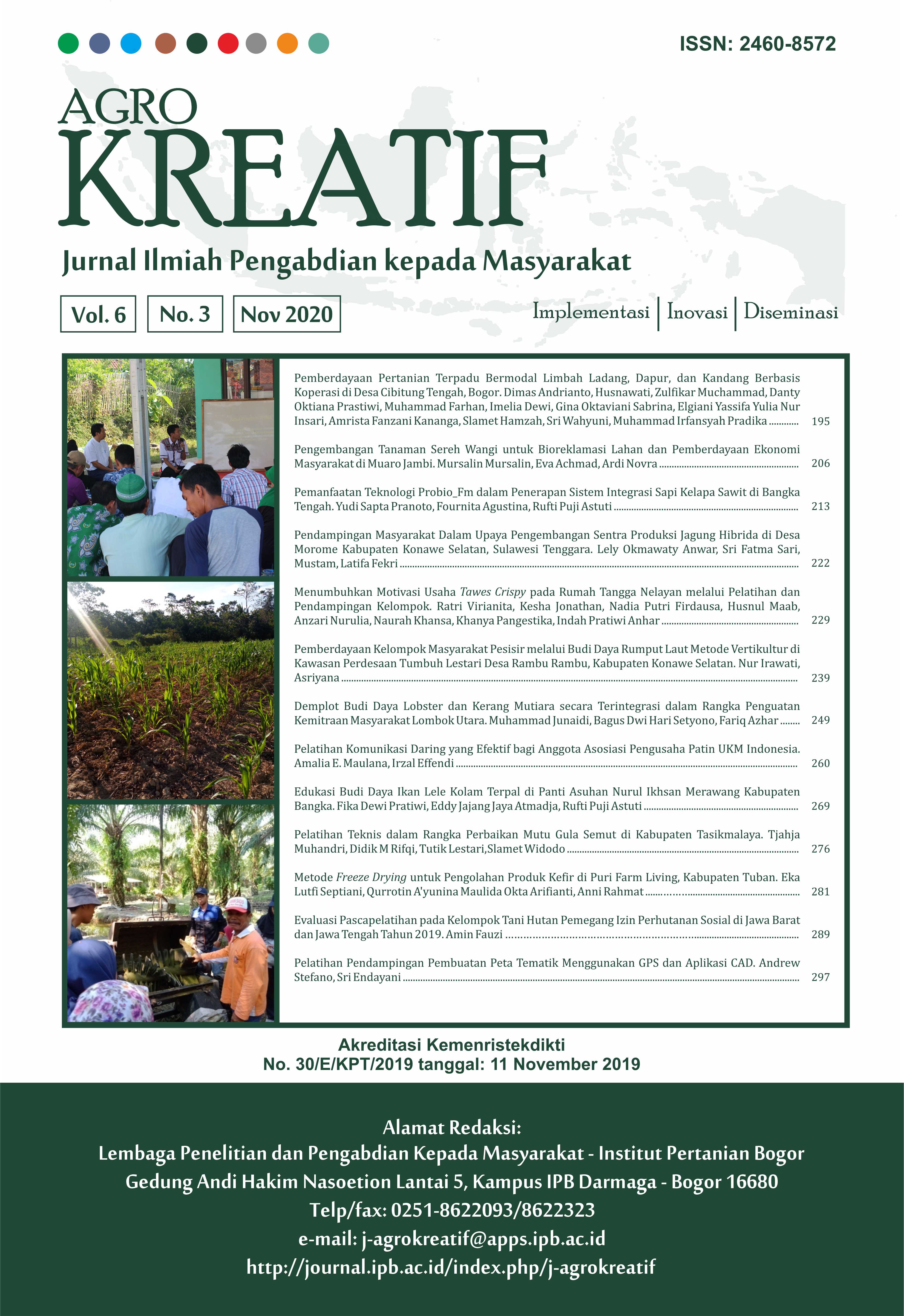Pemberdayaan Kelompok Masyarakat Pesisir melalui Budi Daya Rumput Laut Metode Vertikultur di Kawasan Perdesaan Tumbuh Lestari Desa Rambu Rambu, Kabupaten Konawe Selatan
Abstract
Rambu-rambu Village is one of the villages clustered within the Tumbuh Lestari rural area of North Konawe District. The main purpose of this project was to empower the coastal community groups in Rambu-rambu Village through the introduction of in-cage verticulture farming of seaweed. The project was carried out within the scheme of Community Service Program (PKM/Pengabdian Kepada Masyarakat) funded by the University of Halu Oleo. The project lasted for 30 days from 29 June to 28 July 2019. The activity consisted of three stages, are initial dissemination activity, preparation of the training, and implementation of training of seaweed culture. The project involved 20 students of the University of Halu Oleo and 42 people from fishermen, fisherme wifes, and farmer groups. Before the training was conducted 66.7% of the participants did not have the knowledge and after the training 71.4% of the respondents gained an understanding regarding the seaweed verticulture farming method. The improvement of skill was also evident where before the training, 81% of the participants were not able to do seaweed farming method and after the training, 61.9% of the participants were capable or skilled of repeating the seaweed verticulture method. The increased knowledge of the participants could be described from their ability to clearly explain types of seaweed species used, the benefits of seaweed, and the characteristics of high quality of seaweed seed. The improved skill of the participants were also observed from their skill in constructing the seaweed raft and seaweed net cage, tying up the seaweed seed, and conducting the observation of water quality condition in the location of seaweed farming. The result of this activity showed an increased of knowledge and skill of the trained participants regarding seaweed farming using verticulture method.
Downloads
References
Kemendesa. 2017. Rencana Pengembangan Kawasan Perdesaan Kabupaten Konawe Selatan. [Internet]. [Diunduh 8 September 2019]. Tersedia pada: http://rpkp.org/listings/kab-konawe-selatan/.
Aslan LM, Rahman A. 2010. Pengaruh Jarak Tanam dan Bobot Bibit yang Berbeda Terhadap Pertumbuhan Rumput Laut Varietas Merah Jenis Kappaphycus alvarezii dengan Menggunakan Metode Vertikultur. Jurnal Aqua Hayati. 7(1) :10‒18.
Aslan LM, Rahman A. 2010b. Pengaruh Jarak Tanam Bibit yang Berbeda Terhadap Pertumbuhan dan Kadar Karaginan Rumput Laut (Kappaphycus alvarezii) Varietas Cokelat dengan Metode Long Line. Jurnal Aqua Hayati. 7(2): 16‒23.
Humas DITJEN Perikanan Budidaya. 2020. Siaran Pers Genjot Nilai Ekspor KKP Target Produksi 10,99 Juta Ton Rumput Laut. [Internet]. [Diunduh 31 Maret 2020]. Tersedia pada: https://kkp.go.id/artikel/16505-genjot-nilai-ekspor-kkp-targetkan-produksi-10-99-juta-ton-rumput-laut-di-2020).
Pong-Masak PR, Sarira NH. 2018. Penentuan Jarak Tanam Optimal Antar Rumpun Bibit pada Metode Vertikultur Rumput Laut. Jurnal Perikanan Universitas Gadjah Mada. 20 (1): 23‒30. https://doi.org/10.22146/jfs.33310
Pong-Masak PR, Sarira NH. 2015. Petunjuk Teknis Teknologi Budidaya Rumput Laut Kappaphycus alvarezii dengan metode vertikultur. Gorontalo (ID): Loka Riset Budi Daya Rumput Laut.
Pong-Masak PR, Sarira NH. 2016. Pertumbuhan dan produksi rumput laut Kappaphycus alvarezii dengan aplikasi metode vertikultur di Kabupaten Buton Tengah, Provinsi Sulawesi Tenggara. Dalam: Prosiding Forum Inovasi Teknologi Akuakultur.
Syahlun, Rahman A, Ruslaini. 2013. Pertumbuhan Rumput Laut (Kappaphycus alvarezii) Strain Cokelat dengan Metode Vertikultur. Jurnal Mina Laut Indonesia. 1(1): 122‒132.
Wijayanto TH, Ilham, Purwanti TA. 2019. Teknik Budi daya Rumput Laut Kappaphycus Alvarezii Dengan Metode Vertikultur. Buletin Teknik Litkayasa Akuakultur. 7(2): 99‒105
This work is licensed under a Creative Commons Attribution-NonCommercial 4.0 International License.



















